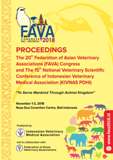PCS-16 Determaining Surgical Method by Meniscectomy Induction on Garut sheep (Ovis aries) for early stage of Osteoarthritis
Abstract
Osteoarthritis (OA) is the most common joint disease that cause of pain and disability by various factors such as advanced age, obesity, trauma, and arthritis disease. These factors affect by degeneration of the cartilage surface, leading to loss of matrix include proteoglycan osteophyte formation, subcondral and synovial membrane affected. In the healthy joint, meniscus, articular cartilage, subchondral bone, and synovial membrane provide support to the joint. The meniscus is an important load bearing structure and has nutritive as well as lubricating properties in the knee joint as well (Little et al. 2010).
Animal models are research materials that can be used in studying potential pathogenesis and therapy in various diseases in humans. Sheep are commonly large animal model of OA because of the availability, ease of handling, and have a similarities with humans in size and structure of joint. In the development of science, sheep can be used as an animal model in studying the pathogenesis of diseases in human orthopedics studies such as joints, ligaments, and bones. Garut sheep is an Indonesian germplasm indigenous that has the structure, density, and size of joint anatomy that are similar in human joints rather than other small animals. This is the basis of the utilization of Garut sheep as an animal model in human orthopaedic. (Little et al. 2010; Gregory et al. 2012).
The aim of this study was to identify and analyze the determining surgical method by meniscectomy induction on Garut sheep with 8 weeks post meniscectomy observation for early stage of OA.

